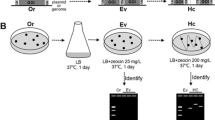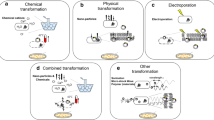Abstract
The gfp (green fluorescent protein) gene has previously been used to construct a variety of reporter plasmids for Gram-positive bacteria for bacterial localization and gene expression studies. When a native red-shifted gfp variant (gfp3) was cloned into an expression vector using the P xyn promoter and used to transform the soil-borne pathogen Listeria monocytogenes, only a small proportion of the population was seen to fluoresce when examined by epifluorescence microscopy. When the P xyn promoter was replaced with the P xylA promoter, with accompanying modification of the translation initiation region of the gfp3 gene, a homogeneously fluorescent population of cells was obtained. When expressed in other Gram-positive organisms, such as Staphylococcus aureus and Bacillus subtilis, the translationally enhanced gene also resulted in high-level and homogeneous GFP production within the bacterial population. High-level expression of these reporter constructs in L. monocytogenes was evaluated to determine if it had any detrimental biological effect during intracellular infection of eukaryotic cell lines. The gfp3 + Listeria were found to invade equally as well as the wild-type cells; showing that these expression systems can be used to monitor the bacterium in natural environments. Based on these results, similar translationally enhanced vectors were also developed using unstable GFP3 variants, which retain their short-half life characteristics in L. monocytogenes and therefore can be used as a sensitive monitor of gene expression.
Similar content being viewed by others
References
Anderson JB, Sternberg C, Poulsen LK, Bjørn SP, Givskov M, Molin S (1998) New unstable variants of Green Fluorescent Protein for studies of transient gene expression in bacteria. Appl Environ Microbiol 64:2240–2246
Augustin J, Gotz F (1990) Transformation of Staphylococcus epidermidis and other staphylococcal species with plasmid DNA by electroporation. FEMS Microbiol Lett 66:203–208
Ausubel FM, Brent R, Kingston RE, Moore DD, Seidman JG, Smith JA, Struhl K (1994) Current Protocols in Molecular Biology. John Wiley and Sons, Chichester, UK
Boylan RJ, Mendelson NH, Brooks D, Young FE (1972) Regulation of the bacterial cell wall: Analysis of a mutant B. subtilis defective in biosynthesis of teichoic acid. J Bacteriol 10:281–290
Bron S, Venema G (1972) Ultraviolet inactivation and excision repair in Bacillus subtilis. Construction and characterisation of a transformable eightfold auxotrophic strain and two ultraviolet sensitive derivatives. Mutat Res 15:1–10
Cormack BP, Valdivia RH, Falkow S (1996) FACS optimised mutants of the green fluorescent protein (GFP). Gene 173:33–38
Cossart P, Mengaud J (1989) Listeria monocytogenes: a model system for the molecular study of intracellular parasitism. Mol Biol Med 6:463–474
Dabiri GA, Sanger JM, Portnoy DA, Southwick FS (1990) Listeria monocytogenes moves rapidly through the host-cell cytoplasm by inducing directional actin assembly. Proc Natl Acad Sci USA 87:6068–6072
Delagrave S, Hawtin RE, Silva CM, Yang MM, Youvan DC (1995) Red shifted excitation mutants of the green fluorescent protein. Bio Technology 13:151–154
Edwards DH, Errington J (1997) The Bacillus subtilis DivIVA protein targets to the division septum and controls the site specificity of cell division. Mol Microbiol 24:905–915
Gaillard JL, Berche P, Mounier J, Richard S, Sansonetti P (1987) In vitro model of penetration and intracellular growth of L. monocytogenes in human enterocyte-like cell line Caco-2. Infect Immun 55:2822–2829
Heim R, Cubitt AB, Tsien RY (1995) Improved green fluorescence. Nature (London) 373:663–664
Jacobs M, Hill PJ, Stewart GSAB (1991) Highly bioluminescent Bacillus subtilis obtained through high-level expression of a luxAB fusion gene. Mol Gen Genet 230:251–256
Keiler KC, Waller PRH, Sauer RT (1996) Role of a peptide tagging system in degradation of proteins synthesised from damaged messenger RNA. Science 271:990–993
Kuhn M, Kathariou A, Goebel W (1988) Hemolysis supports survival but not entry of the intracellular bacterium Listeria monocytogenes. Infect Immun 56:3477–3486
Kreiswirth BN, Lofdahl S, Betley MJ, O'Reilly M, Schlievert PM, Bergdoll MS, Novick RP (1983) The toxic shock syndrome exotoxin structural gene is not detectably transmitted by a prophage. Nature 305:709–712
Knutton S, Baldwin T, Williams PH, McNeish AS (1989) Actin accumulation at sites of bacterial adhesion to tissue culture cells: Basis of a new diagnostic test for enteropathogenic and enterohemorrhagic Escherichia coli. Infect Immun 57:1290–1298
Morin JG, Hastings JW (1971) Energy transfer in a bioluminescent system. J Cell Physiol 77:313–318
Mounier J, Ryter A, Coquis-Rondon M, Sansonetti PJ (1990) Intracellular and cell to cell spread of Listeria monocytogenes involves interaction with F-actin in the enterocyte-like cell line Caco-2. Infect Immun 58:1048–1058
Park SF, Stewart GSAB (1990) High-efficiency transformation of Listeria monocytogenes by electroporation of penicillin treated cells. Gene 94:129–132
Qazi SNA, Hill PJ, Rees CED (1998) Expression of green fluorescent protein (GFP) in Gram positive bacteria. In: Roda A, Pazzagli M, Kricka LJ, Stanley PE (eds) Bioluminescence and Chemiluminescence Perspectives for the 21st Century, Proceedings for the 10th International symposium. John Wiley and Sons, Inc, New York, pp 463–466
Qian L, Wilkinson M (1989) DNA fragment purification: Removal of agarose 10 minutes after electrophoresis. BioTechniques 10:736–738
Saiki R, Gelfand DH, Stoffel S, Scharf SJ, Higuichi R, Horn GJ, Mullis KB, Erlich AH (1988) Primer directed enzymatic amplification of DNA with a thermostable DNA polymerase. Science 239:487–491
Sambrook J, Fritsch EF, Maniatis T (1989) Molecular Cloning; A Laboratory Manual, 2nd ed. Cold Spring Harbor Press, Cold Spring Harbor, NY, pp
Schmiedel D, Kintrup M, Küster E, Hillen W (1997) Regulation of expression, genetic organisation and substrate specificity of xylose uptake in Bacillus megaterium. Mol Microbiol 23:1053–1062
Sharpe ME, Errington J (1999) Upheaval in the bacterial nucleoid—an active chromosome segregation mechanism. Trends Genet 15:70–74
Sullivan MA, Yababin RE, Young FE (1984) New shuttle vectors for Bacillus subtilis and Escherichia coli which allow rapid detection of inserted fragments. Gene 29:21–26
Theriot JA, Mitchison TJ, Tilney LG, Portnoy DA (1992) The rate of actin-based motility of intracellular Listeria monocytogenes equals the rate of actin polymerisation. Nature 357:257–260
Tilney L, Portnoy DA (1989) Actin filaments and the growth and movement, and the spread of the intracellular bacterial parasite, Listeria monocytogenes. J Cell Biol 109:1597–1608
Vellanoweth RL (1993) Translation and its regulation. In: Sonenshein AL, Hoch JA, Losick R (eds) Bacillus subtilis and Other Gram Positive Bacteria Biochemistry, Physiology and Molecular Genetics. American Society for Microbiology, Washington, DC, pp 699–711
Yanisch-Perron C, Viera J, Messing J (1985) Improved M13 phage cloning vectors and host strains: nucleotide sequences of the M13amp18 and pUC vectors. Gene 33:103–119
Author information
Authors and Affiliations
Corresponding author
Rights and permissions
About this article
Cite this article
Qazi, S.N.A., Rees, C.E.D., Mellits, K.H. et al. Development of gfp vectors for expression in Listeria monocytogenes and other low G+C gram positive bacteria. Microb Ecol 41, 301–309 (2001). https://doi.org/10.1007/s002480000091
Received:
Accepted:
Issue Date:
DOI: https://doi.org/10.1007/s002480000091




